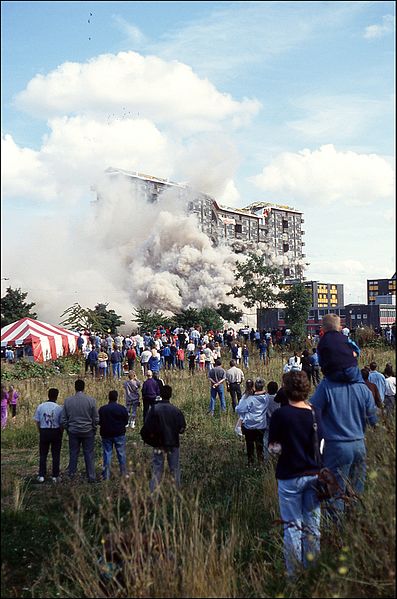A crowd of people stood, motionless, as they witnessed the demolition of the block known as Queen Elizabeth Flats. A quick flash, a thunder-like sound, and a cloud of smoke and ash, and building number 6 was brought to the ground.
This building was only one of the buildings scheduled to be torn down in a similarly spectacular way.
It was September 12, 1993, when the huge crowd of people came to witness their homes, as well as the homes of their neighbors, being blown to pieces. The buildings were located in what was known as Hutchesontown C, part of Hutchesontown in Glasgow, Scotland, and their colossal size was their downfall.

For a full decade, the buildings served their purpose well — but as time passed, maintenance became a cumbersome load upon the shoulders of the Hutchesontown Tenants Association.
In November 1976, a meeting was held that was attended by Scottish politician Frank McElhone, among others. The focus of the meeting was to come up with solutions for dealing with the, by now, damp-infested buildings.

The popularity of the buildings among their tenants declined as rapidly as it grew. Many tenants decided to go on strike until living conditions improved. The damp and dark place became a popular site for vandals and criminals, who caused further torment to the residents.
The history of the buildings isn’t all dark and gloomy; they were initially met with enthusiasm and expected to create perfect homes. The flats were built in 1960, the year when Psycho had its premiere and To Kill a Mockingbird was published. Seven years later, Jimi Hendrix would set his guitar on fire in Glasgow.
The area was split into five areas – designated “A” through “E” – each with its own architect and designer. Hutchesontown district was ready to be converted from an area of slum-housing into an organized neighborhood.

The architect for Area C was Sir Basil Urwin Spence, a Scottish architect known for a number of projects including Edinburgh University Library, part of Glasgow Airport, the British Embassy in Rome, and many others. One year later, some of the buildings were erected and a commemorative plaque was revealed on June 30, 1961.
Initially, there were three zones: A, B, and C. The Glasgow Corporation architects were responsible for Zone A; Robert Matthew, initially an assistant of Spence, took on Zone B; and Spence was responsible for Hutchesontown C.

The designs were initially considered to be flawless but time did not prove this to be the case. Matthew’s building was the only one to escape public execution.
And an execution it was. Helen Tinney, a woman in her 60s, was hit by flying debris and killed after the company tasked with razing the buildings loaded them with too many explosives. Besides Helen’s death, four more spectators were hit and injured. This prompted Glasgow’s authorities to forbid the use of explosives for demolition for a decade.

The Brutalist 20-story buildings were designed with the community in mind and the communal terraces added to the overall implementation of the idea.
According to Glasgow University, “These balconies were seen as ‘a perpetuation of the green’… to give the baby an airing, and to provide a garden fence to gossip over.” The Hutchesontown district was declared a CDA – Comprehensive Development Area – once World War II was over. Initially overcrowded and poverty-stricken, the zone went through some serious changes to become the new residential area.

“An exhibition paying tribute to the man who designed the notorious Hutchesontown C block has opened in the Gorbals,” writes the Evening Times in their article dated January 16, 2008. Even though the Hutchesontown C block was erased from the face of the earth, much of Spence’s work remains and continues to inspire.
